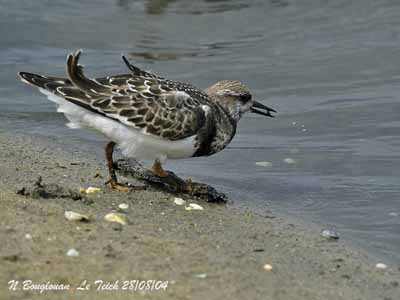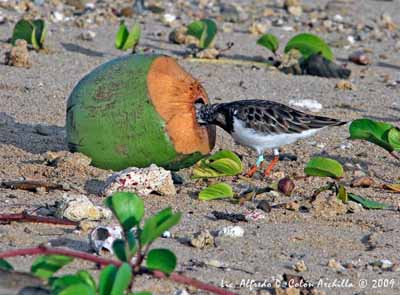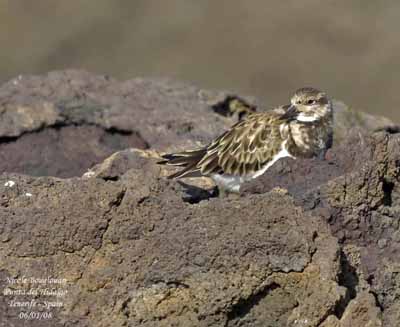
PROTECTION / THREATS / STATUS:
The Ruddy Turnstone is relatively common in its range, and even extending the wintering areas in Europe.
Populations are globally stable and not threatened at this moment.
Fr: Tournepierre à collier
All : Steinwälzer
Esp : Vuelvepiedras Común
Ital: Voltapietre
Nd: Steenloper
Sd: Roskarl
Port: Rola-do-mar
Photographers :
Didier Buysse
Vision d’Oiseaux
Alfredo Colón
Puerto Rico Wildlife
Steve Garvie
RAINBIRDER Photo galleries
Nicole Bouglouan
PHOTOGRAPHIC RAMBLE
Texte de Nicole Bouglouan
Sources :
HANDBOOK OF THE BIRDS OF THE WORLD Volume 3 by Josep del Hoyo-Andrew Elliott-Jordi Sargatal - Lynx Edicions - ISBN : 8487334202
THE HANDBOOK OF BIRD IDENTIFICATION FOR EUROPE AND THE WESTERN PALEARCTIC by Mark Beaman, Steve Madge - C.Helm - ISBN: 0713639601
THE COMPLETE BOOK OF BRITISH BIRDS – Written by “Royal Society for the Protection of Birds” experts - Préface de Magnus Magnusson - Michael Cady- Rob Hume Editors - ISBN: 0749509112
SHOREBIRDS by Peter Hayman, John Marchant and Tony Prater – Christopher Helm – 1986 – ISBN: 0747014035
GUIDE DES LIMICOLES de D. Taylor - Delachaux et Niestlé - ISBN : 2603014080
ENCYCLOPEDIE DES OISEAUX DE FRANCE ET D’EUROPE – de Peter Hayman et Rob Hume - Flammarion – ISBN : 2082009920
ENCYCLOPEDIE DES OISEAUX DE FRANCE ET D’EUROPE – de Peter Hayman et Rob Hume - Flammarion – ISBN : 2082009920
The Birds of North America online
What Bird-The ultimate Bird Guide (Mitchell Waite)
Wikipedia (Wikipedia, The Free Encyclopedia)
Ruddy Turnstone
Arenaria interpres
Charadriiforme Order – Scolopacidae Family
BIOMETRICS:
Length: 21-26 cm
Wingspan: 50-57 cm
Weight: 84-190 g
DESCRIPTION:
Closely associated to the water, the Ruddy Turnstone is very active, searching for food on rocks, in algae, on beaches. Very conspicuous in flight, this bulky shorebird occurs in the coasts of the whole world according to the seasons.

Adult male in breeding plumage has rufous-chestnut upperparts with blackish patches on mantle, wings and tail. Rump is dark brown.
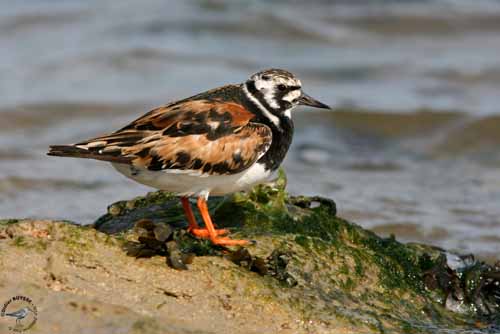
When in flight, we can see the white back and uppertail coverts. There are a white wing bar and a triangular patch on the inner wing. The tail shows black subterminal band and narrow white terminal band.
On the white underparts, we can see a black breast band, reduced in the middle.
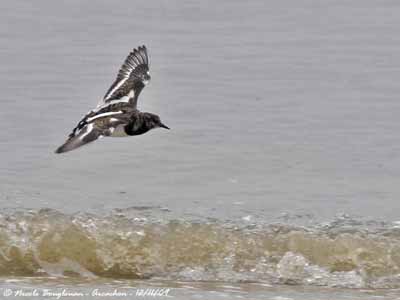
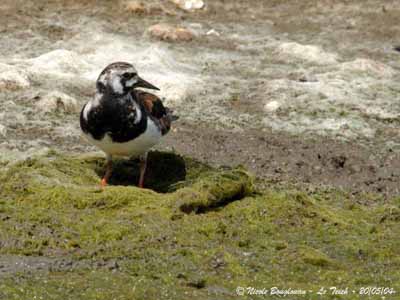
Head and neck show black and white pattern and finely streaked crown. The black stripes join the black upper breast and the black breast band.
The straight, pointed, chisel-shaped bill is black. Eyes are dark brown. Legs and feet are red-orange.
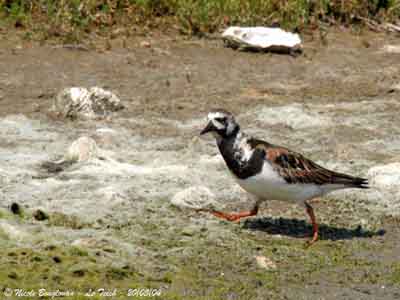
Adult male in non-breeding plumage is duller. Upperparts are dark greyish-brown and blackish. Feathers are edged pale buff, giving scaled effect.
The head is dark greyish-brown to blackish-brown. The breast band is blackish.
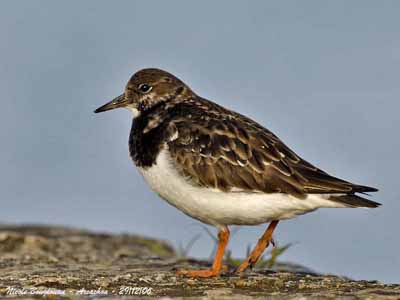
Female has more streaked crown and brownish nape. Upperparts are duller and the breast band is slightly flecked with pale buff.
Juvenile resembles non-breeding adult, but upperparts are browner with buff-edged feathers and paler head. It can breed when two years old.
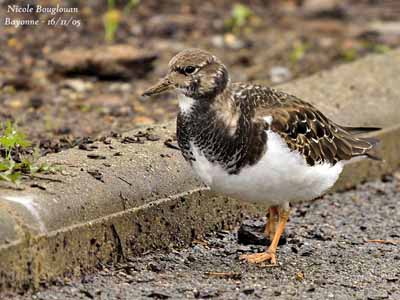
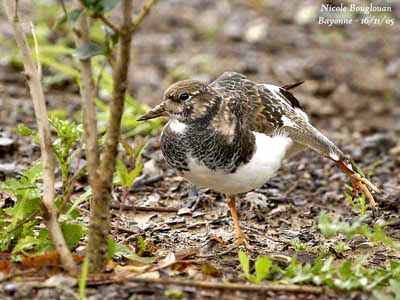
We can find two subspecies:
A.i. interpres breeds in Greenland, N Eurasia and NW Alaska.
It winters on the coasts of W Europe, Africa, S Asia, Australasia and S Pacific islands. Some populations occur on the Pacific coast of North America, from California to Mexico.
A.i. morinella is a New World subspecies and breeds in NE Alaska and most of Arctic Canada.
It winters on the coasts from South Carolina and Gulf of Mexico, to SC Chile and Northern Argentina.
This one is slightly smaller than the nominate race, with fine paler streaks on crown. Scapulars and upperwing coverts show more extensive deep chestnut. In winter plumage, some chestnut patches are visible but duller.
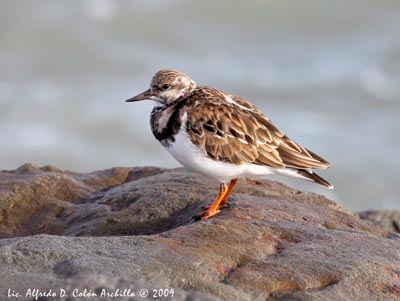
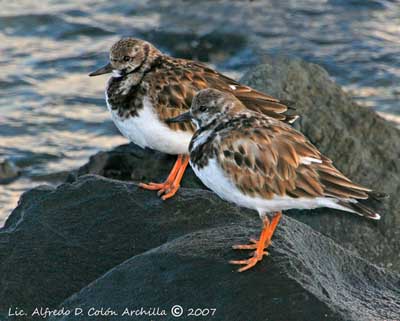
VOICE: SOUNDS BY XENO-CANTO
The Ruddy Turnstone’s common call is a low, rapid, rattling “tuk-è-tuk-tuk”. The call is louder if the bird is disturbed “tchit-èk”.
The contact call heard among the foraging groups is a low “tuk”.
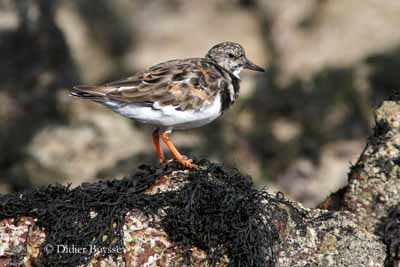
HABITAT:
The Ruddy Turnstone frequents the stony coastal plains, the tundra and marshy areas in lowlands. This species remains close to moist areas until late summer.
It is mainly coastal outside the breeding season. During migrations, it can be seen inland where it frequents the short-grass salt-marshes. But it favours the stony shores, rocks, breakwaters, sandy beaches with seaweed, sheltered inlets, estuaries, exposed reefs, mudflats and lake shores.
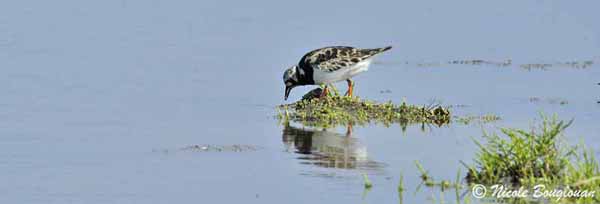
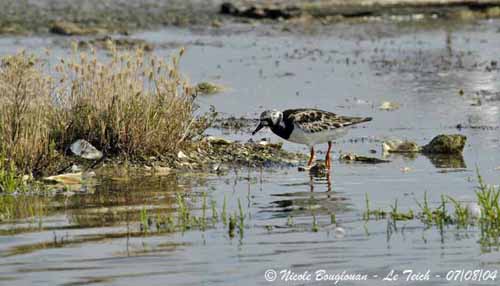
RANGE:
The Ruddy Turnstone breeds in the northern coasts of Eurasia and North America, and winters along the southern coasts of all the continents.
Highly migratory with high fidelity to wintering areas, they migrate in flocks of 10’s birds.
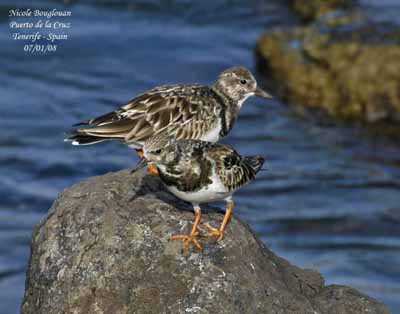
BEHAVIOUR:
The Ruddy Turnstone feeds mainly on insects during the breeding season, mainly Diptera, Lepidoptera and Hymenoptera, beetles and spiders.
They feed by probing and jabbing, and may also take some plant matter.
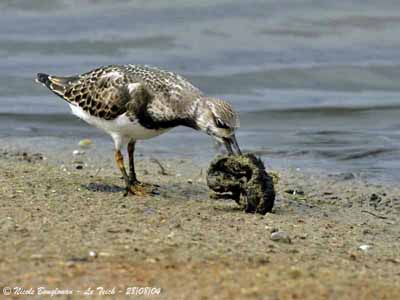
Outside the breeding season, it feeds on varied items such as insects, crustaceans, molluscs, echinoderms and small fish. During winter, it may feed on carrion, dead fish and mammals, and bird’s eggs. They will eat almost anything.
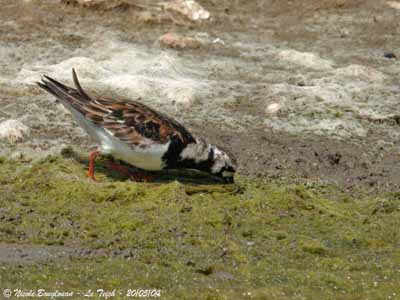
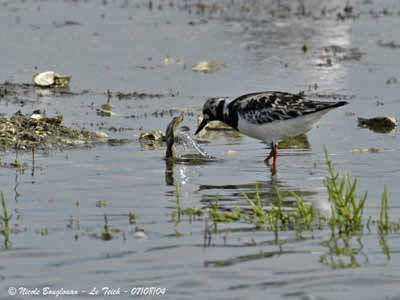
If it is impossible to flip over a heavier stone, the bird tries to push it with the breast, but its strong neck and bill allow it to turn over small stones and other items, in order to find its preys.
The Ruddy Turnstone can run easily, but it walks with a rolling gait.
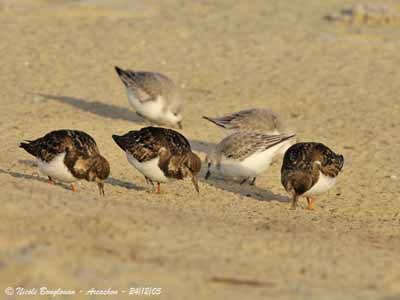
This species usually forages in small groups with Sanderlings on the winter areas. The Ruddy Turnstones gather at large roosts of several hundreds of birds to sleep and rest. They are known to show a clear social structure but they also establish dominance hierarchies, involving fighting, sometimes very hard, until the death of one bird.
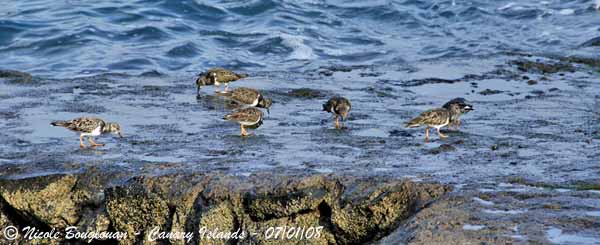
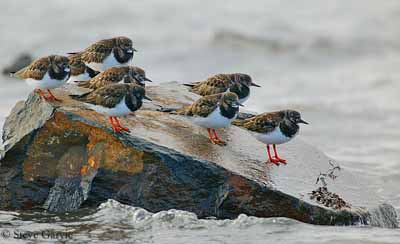
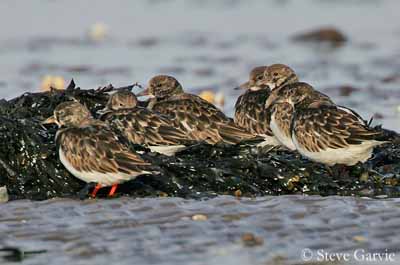
Some displays show the bird pursuing other turnstone while calling loudly, with rounded back and fanned tail. On breeding areas, the male circles above its territory while calling, performing slow, deep wing-beats. Several birds may perform aerial chases over the tundra. The male also makes nest-like scrapes within the territory, as part of courtship, often in the close vicinity of the site selected by the female.
FLIGHT:
The Ruddy Turnstone performs powerful, direct flight on stiff wings, with shallow wing-beats. When migrating, the birds fly in loose line.
The flight allows seeing the conspicuous white wing and body patches.
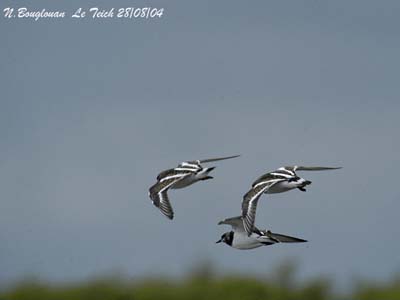
REPRODUCTION:
The laying occurs from mid-May to early July, and mainly mid-June in Canada.
The Ruddy Turnstone is monogamous and usually nests solitary or in very loose colonies with about 3-8 pairs / km2.
The nest is on the ground, and often concealed in or under vegetation, but sometimes in open areas. It is a shallow depression lined with varied plant items found in the habitat. The nest is in dry, open tundra, both in flat areas and slopes, but always near water such as ponds, lakes and streams.
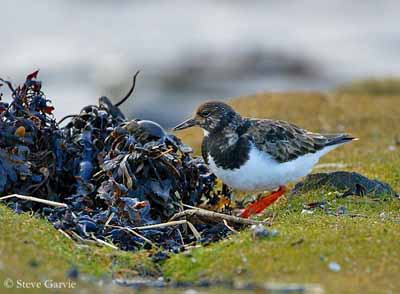
Female lays 2-4 olive to olive-buff eggs with dark markings, at one day interval, occasionally two. Incubation lasts about 22-24 days, shared by both parents but mainly by female. Chicks have buffy-grey to cinnamon-buff upperparts and pale grey underparts. Both adults care them for one or two weeks. They fledge about three weeks after hatching.
The female leaves first, and the male starts to migrate after the chick have fledged.
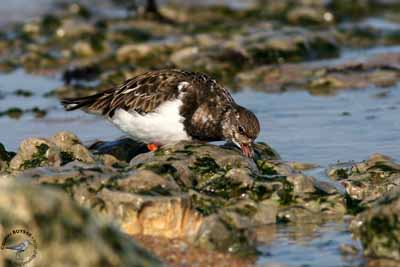
DIET:
The Ruddy Turnstone’s name suggests that this bird forages by turning over stones, but also seaweeds, leaves, shells and varied objects, in order to find invertebrates. Then, it pecks or pursues them. It occasionally may swim if necessary.
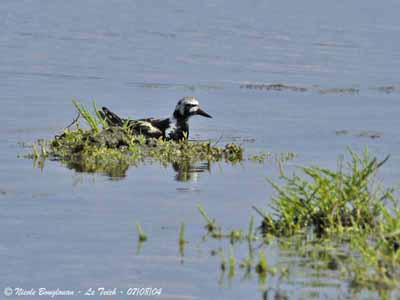
This species feeds mainly on insects and larvae during the breeding season, but it also consumes numerous food items outside this period, such as crustaceans, molluscs, echinoderms, small fish, dead fish and mammals as carrion, insects and bird’s eggs.
The Ruddy Turnstone frequently scavenges and even takes bread from humans. According to the range, it may eat some items such as coconuts and carrion.
